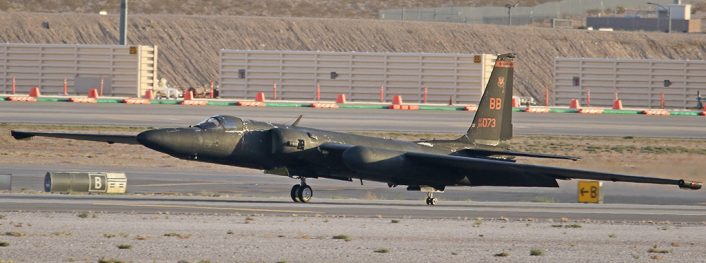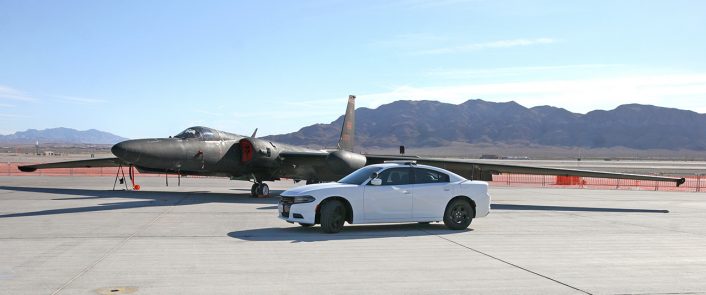It Wasn’t on the Schedule, but a Late Tip at Aviation Nation Air & Space Expo Gave Us Unique Insights into The Historic U-2.
The fine print in every air show schedule reads, “Aircraft appearances are subject to change”.
It’s a reminder that the primary mission of military aircraft is not display, but operational readiness. Sometimes that means an aircraft scheduled to appear at a flight demonstration or static display gets cancelled because of higher priorities.
But sometimes it also means one gets added.
That was the case at the 2017 Aviation Nation Air & Space Expo at Nellis Air Force Base. A Saturday flyover of a B-2 Spirit strategic bomber was moved off the schedule when the scarce, national security asset was assigned to a higher priority mission. With only about twelve of the B-2 Spirit fleet in operational status and the looming North Korean crisis many aviation enthusiasts thought we would lose the flyover to higher tasking. What we didn’t know was that the good folk at Aviation Nation Air & Space Expo would replace it with something even better.
It pays to keep your eyes open at an airshow, and especially at Aviation Nation. Nellis is a hub of training activity in one of the busiest military aircraft training regions in the world. If you’re a keen observer, you may spot an unusual flight suit patch, a different name tag, or something else extraordinary. There is so much going on at Nellis it can be tricky to pay attention to everything at once. It’s like looking for the best candy in the world’s largest candy shop. But on the Friday Veteran and Military Appreciation Day and Working Media Day, our helpful media escort, Mr. Mike Young, a retired Public Affairs Officer in the Air Force, found us a rare gem. Mr. Young was working with the Nellis 99th Air Base Wing/Public Affairs Office at Nellis. His unenviable job was to follow me around all day to make sure I didn’t stray off anywhere I wasn’t supposed to, photograph anything off limits, or touch any switches in cockpits that ought to not be touched.
As our media escort ushered us through the many static displays and aircrew introductions I spotted an unusual patch on an officer’s flight suit. The patch read, “Dragon Lady 1000, Solum Volamus.” And in case that didn’t raise an eyebrow, it said quite plainly across the top: “Lockheed U-2”.
We had just stumbled upon one of the rarest aircraft pilots in aviation history, a Lockheed U-2 spy plane pilot.
I often feel for pilots at airshows, especially when a gawky fanboy reporter like me is fawning over them, asking, “Can I take a photo with you Sir?” But they always do, and with a smile. This was no exception.
With accommodating enthusiasm, the U-2 pilot I spotted in the crowd confirmed he did indeed fly the Dragon Lady, one of the most difficult planes to fly in one of the most dangerous roles in any air force. He went on to leave us with another gem, “It will be arriving here today at 4:30 PM, right after the Thunderbirds practice is over.”
Jackpot.
Few people have ever seen a U-2 high altitude reconnaissance plane up close. First flown in 1955, only 104 were built. The U.S. continues to use about forty U-2s in their intended surveillance role. Interestingly, Taiwan operated a few of the aircraft at one time, but they have been, and continue to be mostly employed by the U.S. Air Force and NASA. The Central Intelligence Agency also operated the U-2 in the intelligence gathering role.
While every aspect of the U-2, its mission, operation and performance are remarkable, certainly the most remarkable chapter in the U-2’s history is the Francis Gary Powers incident.
On May 1, 1960, Operation Grand Slam, managed by the C.I.A., was initiated. A U-2 spy plane flown by Capt. Francis Gary Powers overflew the Soviet Union to obtain photos of ICBM bases and a plutonium manufacturing facility. The Soviets knew the American U-2 was coming, and put all their air defense units on alert. After repeated unsuccessful attempts to intercept the U-2 spy plane along its route using fighter aircraft, none of which could reach it because of its extreme high altitude, a salvo of three SA-2 Guideline surface to air missiles (SAMs) was able to shoot down Capt. Powers’ U-2. The missile salvo also accidentally shot down a Soviet MiG-19 aircraft chasing Powers’ U-2. Although Capt. Powers was able to eject and survive the shoot-down, the Soviet pilot trying to intercept him, Senior Lieutenant Sergei Ivanovich Safronov of the 764th Fighter Aviation Regiment, Soviet Air Defense Force at Bolshoye Savino Airport, died in the tragic fratricide incident.
If people hadn’t known about the most secret spy plane in the U.S. arsenal before the Gary Powers incident, that soon changed when the Soviets paraded the captured Capt. Powers in front of newsreel cameras and displayed the wreckage of his U-2 spy plane. Overnight the U-2 went from national security secret to the most famous airplane in the world at the time.
Since then the U-2 and its related versions such as the TR-2 have gone on to perform the strategic and tactical reconnaissance mission around the world. The aircraft has also been flown to collect high altitude weather data.
Everything about operating the U-2 is remarkable. Its pilots, among the most skilled in any air force, wear an ultra-high altitude pressure suit that is effectively a spacesuit, including the large bubble-like helmet. Pilots must pre-breath pure oxygen for an extended time prior to their high-altitude surveillance missions, the time varying depending on the duration of their mission. Long missions can last a staggering 10+ hours. The pilots also wear radiological dosimeters to record the amount of solar radiation they are exposed since they fly at the outer limits of the atmosphere and are exposed to higher levels of harmful radiation from the sun. During periods of elevated sunspot activity, the pilots do not fly high altitude missions. Pilots eat pureed paste-like food through a tube during long missions. If a pilot has to urinate during a mission, they do so into a flexible bladder sewn into the suit. If they have to defecate, something avoided through careful management of diet in the days prior to a long-range, high-altitude flight, the suit is no longer useable. Once the helmet is donned and the pilot is ready to fly, they can’t even scratch an itch on their face.
I got a privileged opportunity to sit in the operational U-2 flown into Nellis AFB by two of the officers who fly her. For security reasons, they asked that their real names not be used.

The first thing that occurred to me climbing inside the aircraft is how small it is. I was wearing summer street clothes. In a high-altitude pressure suit I have no idea how someone could wedge themselves into the compact space.
Flight controls and instrumentation in the U-2 I sat in seemed antiquated compared to more modern aircraft like the F-22 and F-35. Recall that the first U-2, designed by the famous Kelly Johnson of the Lockheed Skunkworks, was flown in 1955, so these are all old aircraft.
All U-2 aircraft go through what is effectively a re-building process called Programmed Depot Maintenance every 4,800 flight hours or every seven years. The aircraft are almost completely disassembled, inspected and necessary components are repaired or replaced. About six of the aircraft are cycled through the extended maintenance procedure per year. This fascinating video shows the process:
Pilots who fly the U-2 are restricted from discussing aircraft performance and mission specifics for security reasons. However, the pilot who briefed me on flight control procedures when operating at the classified operational altitudes showed me how the autopilot controls are used to maintain the aircraft within its very narrow speed and attitude band. Fly too fast and the aircraft is possibly damaged, likely resulting in a crash, fly too slow in the thin air of the outer atmosphere and the aircraft stalls and tumbles out of the sky, hopefully regaining control if it doesn’t disintegrate before it reaches lower, thicker air below 60,000 ft. The difference between max airspeed, the VH airspeed, and VMU airspeed, or minimum unstick airspeed can be incredibly narrow, a band of less than 20 MPH. When you factor in wind speed, vertical acceleration from turbulence and other variables, you quickly begin to understand that a U-2 pilot will be extremely busy during a high-altitude mission just trying to keep the aircraft in the air.

With the tip from the U-2 pilot we met on Friday we also got to see the U-2 arrival and landing, including the unusual procedure of having a fast car driven by another qualified U-2 pilot chase the aircraft down the runway on final approach giving the pilot minor corrections on attitude and line-up. Once the aircraft touches down on the runway the pilot attempts to hold what is ostensibly the world’s largest unicycle on its center main landing gear. As the aircraft slows during roll-out the pilot tries to hold the wingtips off the runway until the final moment. Once they stop on the landing roll, small “pogo” wheels are installed under each wing to keep the wingtips off the pavement and allow the plane to taxi.

Seeing a U-2 in person was a rare treat in aviation history.
On both Saturday and Sunday, everyone attending the airshow got a chance to see the “Dragon Lady”. This incredibly rare and exotic opportunity is just one of the many things that make the Nellis AFB Aviation Nation Air & Space Expo one of the finest air shows anywhere in the world.
TheAviationist.com would like to thank U.S. Air Force 2nd Lt. Marie Ortiz, Chief of Media Operations at the 99th ABW/Public Affairs and Mr. Mike Young, USAF (retired), along with the entire Public Affairs Team at Nellis AFB for their generous assistance in covering not only the arrival of the U-2, but all of the events at the 2017 Aviation Nation Air & Space Expo.









